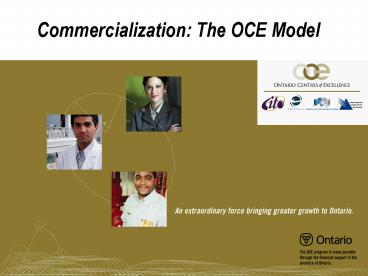Commercialization: The OCE Model PowerPoint PPT Presentation
1 / 18
Title: Commercialization: The OCE Model
1
Commercialization The OCE Model
2
Background
- On April 1, 2004 the four Ontario centres of
excellence - merged to become OCE Inc. These centres include
- Communications and Information Technology Ontario
(CITO) - The Centre for Research in Earth and Space
Technology (CRESTech) - Materials and Manufacturing Ontario (MMO)
- Photonics Research Ontario (PRO)
3
Who We Are
CITO is a division of OCE Inc, a not-for-profit
corporation dedicated to the pursuit of economic
growth through technology innovation OCE
Inc. achieves this by facilitating research and
development collaborations between industry and
academia, that result in the training highly
qualified people, the transfer of knowledge
technology to industry and the commercialization
of research outcomes.
4
What We Do
- Foster networking between industry and academic
partners resulting productive partnerships - Stimulate knowledge growth and innovation by
investing in industrially relevant RD at
academic institutions in collaboration with
business - Create a pool of highly qualified researchers to
enrich Ontarios and Canadas talent base - Invest in new companies to develop and
commercialize research results
5
Business Strategy Lab to market
- Invest in only the best RD in collaboration with
industry - A suite of programs to support the strategy
- Work collaboratively with other agencies
- Provide IP management and commercialization
services - Provide ongoing support to receptor companies
6
Approach to Commercialization
- Investing
- Innovative RD with strong commercial potential
- Companies develop and market product /service
- Licensing / start-ups / early stage companies
- Proof of concept / prototyping / IP protection
- Pre-seed funding
- Leverage VC or other sources of series A
financing - Partnerships Networks
- Business, industry, other agencies the
investment community - Mentoring
- Working with researchers and companies to develop
RD and business plans
7
Complementary Investment Programs
- Research Partnerships Program
- International programs
- Student programs
- Tech Readiness
- Accelerator
8
The CITO Investment Continuum
RPP Programs
Accelerator Program
Tech Readiness
Student Programs
9
OCE Facts
- Over 2,400 researchers involved in projects today
- 84 technology licenses in place last year
- 17 new companies created last year, 50 startups
still in existence - 12,000 students involved in projects since 1987
- 20 spin-off companies
- A comprehensive college strategy
- A growing number of International collaborative
research projects
10
Commercialization Why?
- Why does your institution want to have a
commercialization agenda? - What are the objectives?
- What is the strategy how does it fit with the
overall strategy of the college?
11
A commercialization friendly environment
- The right culture commitment
- The right networks and relationships
- The right projects
- A motivational commercialization policy and
procedure - The right resources and expertise
12
Commercialization options
- Licensing (exclusive and non-exclusive)
- Businesses early stage company growth
- Newco (Start-up)
- Sub - licensing
13
How will you measure success?
- Knowledge transfer
- Relationship building
- Leveraging capabilities and outcomes
- Licensing, royalties, spin offs
14
Intellectual Property and Tech Transfer
- Institutional or inventor ownership?
- Commercialization rights and options
- Individual Institutional or collaborative model
- The major advantage that the colleges currently
have over universities the opportunity to develop
a tech transfer model that works for all colleges
regardless of the scope of their individual RD
agenda
15
Unsolicited Advice to Colleges
- Dont follow the university model
- Collaborate with other colleges on RD and TT
- Bundle technologies to create more value
- Focus RD and TT where you have a competitive
advantage - Harmonize IP and TT policies across colleges
- Give ownership of IP to inventors
- Be driven by the economic growth of your region
not the college - Tech transfer is a cost centre not a profit
centre
16
Required Resources
- Sector expertise
- IP evaluation protection (patent agents)
- Market research
- Licensing negotiation
- Spin-off and business incubation
- Gap funding and access to other capital
17
OCEs Strengths
- Sector focus and expertise
- Broad business background
- Networks and connections
- Funding for RD projects
- Access to seed funding and capital markets
- Independent of conflicting agendas
- Entrepreneurial - nimble
- Results driven
18
Bryan Kanarens bryan.kanarens_at_oce-ontario.org Tel
. (613) 533 6451

